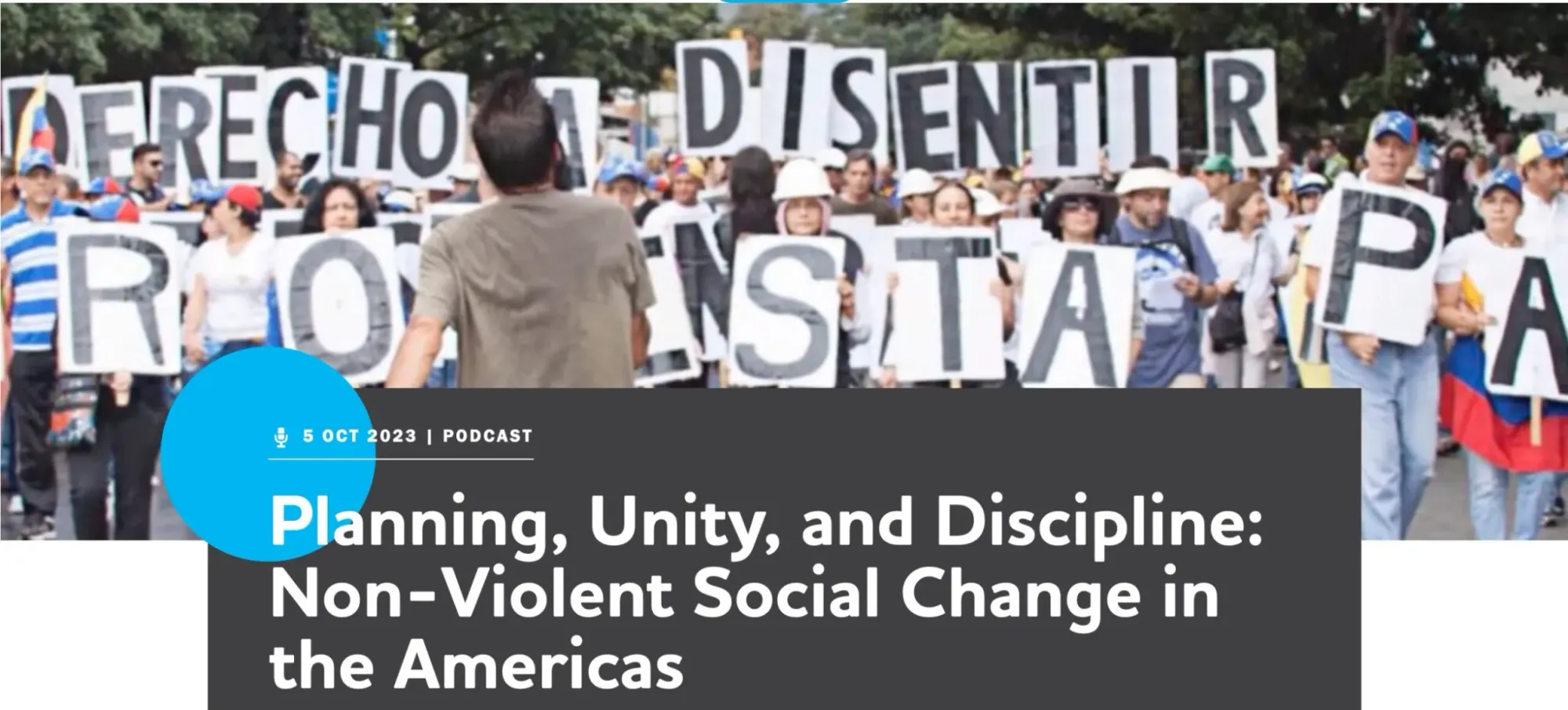Updates from Adam Isacson (October 9, 2023)
Hi, this is Adam. If you're receiving this message, it means you signed up on my website to receive regular updates. If you'd like to stop getting these, just follow the instructions further down.
It was one of those weeks where I was missing new developments because they were happening while I was writing or talking about the previous days' developments. Especially on Thursday, when the Biden administration dropped two bombshell announcements—about the border wall and deporting Venezuelans—while I was drafting our weekly border update.
This week's e-mail has links to that border update; a podcast with experts on non-violent social change in the Americas; a commentary on the admnistration's October 5 border wall announcement; more data insights about migration trends and border drug seizures; short commentaries on historical U.S. aid and judicial presence in Colombia; links to a few recommended articles; and some upcoming events.
Weekly U.S.-Mexico Border Update: October 6, 2023
Read the whole update at WOLA's website.
- Two breaking items: new border wall and Venezuela deportations
Two important policy developments occurred as WOLA was drafting and editing this update on October 5. The Biden administration announced that it will waive environmental, public health, and cultural resource protection laws to expedite the construction of the border wall in south Texas. The State Department announced that it will resume direct deportations of Venezuelan migrants to their home country, an economically collapsed dictatorship that the U.S. government does not formally recognize.
- Border Patrol apprehended about 210,000 migrants in September
Preliminary data indicates that migration increased at the U.S.-Mexico border in September for the third consecutive month. Fiscal 2023 was Border Patrol’s number-two year ever for migrant apprehensions, exceeded only by 2022. 50,000 of September’s Border Patrol apprehensions were reportedly of citizens of Venezuela, which would be a record for a nationality other than Mexico. High migration levels have brought tensions and human rights concerns in San Diego, El Paso, and elsewhere. Deaths of migrants in Border Patrol’s El Paso Sector more than doubled from 2022 to 2023.
- Proposals call for increasing deportations from Mexico and Panama
U.S. and Mexican diplomats are meeting at the highest levels to discuss issues including migration. Mexico has signaled a willingness to deport more citizens of Ecuador, Venezuela and Colombia. The Biden administration is aiming to launch a pilot project to help Panama deport more migrants from the Darién Gap region.
- Mexico updates
About 6,000 people are crossing Mexico’s southern border every day, and the country is on track to exceed 150,000 asylum applications this year. Mexico continues to halt some trains and bus migrants into the interior, while accidents and attacks are claiming many lives along the migration route.
- Darién Gap updates
It appears that 75,268 migrants crossed the Darién Gap in September, the second largest-ever monthly total. A UN survey revealed that the average journey through this treacherous region lasts four days.
Continue here to read the whole thing.
Podcast: Planning, Unity, and Discipline: Non-Violent Social Change in the Americas
The latest episode of WOLA's podcast features two scholar-practitioners who work with non-violent activists around the Americas. I found the advice and insights that María Belén Garrido and Jeff Pugh offered are very relevant for a time when authoritarian populists are gaining power and controlling public conversations. Here’s WOLA’s podcast landing page.

The Administration’s Border Wall Messaging Will Make Your Head Hurt
This post got a lot of traffic this week, maybe because of the snarky title. I added an addendum on Saturday, though, because Thursday's version didn't "nail it."
On Thursday I was focused on the Biden administration's ham-fisted messaging around its border wall announcement, which combined language voicing enthusiasm for border walls with statements of reluctance ("congressional appropriations are making us do this.") But in the original post, I didn't dig into whether congressional appropriations actually forced the administration to waive laws to build these particular 20 miles of wall. An important point, hence the five paragraphs added to the end.
This is a single screenshot from today’s New York Times article about the Biden administration’s announcement that it is building new segments of border wall. The highlighted bits are a few paragraphs apart.

It’s unusual to see that much self-contradiction in such close proximity.
If you listen to President Biden today, it sounds like his administration has been forced, against its will, to waive 26 environmental and cultural laws to build abut 20 miles of border wall in Starr County, in south Texas.
But if you listen to the Department of Homeland Security language in the Federal Register, it looks like they’re doing this out of a newfound enthusiasm for border walls.
Biden is correct: the wall-building money comes from 2019 appropriations, passed for then-president Donald Trump by a Republican congressional majority, which the Biden administration and congressional Democrats were unable to rescind. The Impoundment Control Act says that presidents have to spend money as Congress appropriates it, before it expires.
The money in question is in the blue section of this chart, in the 2019 column. (The chart comes from a January 2020 commentary I wrote for WOLA.) By the time Trump left office, the 2017 money was spent, the 2018 money was all but spent, but most of the 2019 money was not, and the 2020 money hadn’t been touched yet. (See this October 2020 “Border Wall Status” report that I saved.)

So President Biden is right: he had no choice but to spend the border wall money before it expired, presumably with the September 30 end of the government’s 2023 fiscal year. But his administration has done a poor job of explaining that today.
Update October 7: After a lot of conversations about this on October 5 and 6, and I feel I should soften the “Biden is right” language above, because it’s more complicated.
While it’s true that Biden had to use the 2019 appropriations money, it’s unclear whether the Impoundments Act required him to waive 26 laws to proceed with the wall construction.
This is a question that federal courts would probably have to resolve. As seen in recent cases, the decision would likely be made following a lawsuit—possibly filed in the federal judiciary’s conservative Fifth Circuit by Republican state governments. It’s probable that the case would escalate to the Supreme Court. It’s understandable that the Biden administration would prefer not to engage its Justice Department in this litigation, considering it could drag on for a couple of years and potentially result in an unfavorable precedent.
However, the question remains: why didn’t the administration devise a barrier design that met congressional requirements without needing to waive environmental and other laws? Such a design would have been more likely to withstand legal scrutiny, and would have earned less criticism from environmental advocates and the President’s supporters.
One possible explanation is internal bureaucratic politics. The wall designs for Starr County were initially conceived during the Trump administration. It’s plausible that career officials from the Department of Homeland Security and Customs and Border Protection (among them, one suspects, the drafters of that “acute and immediate need” language) were resistant to revisiting the designs. It seems that the Biden administration’s political appointees were not prepared to push back strongly on this issue. So here we are.
The Decision to Restart Deportations to Venezuela… Wow, What a Difference 15 Days Make
Extraordinary and temporary conditions continue to prevent Venezuelan nationals from returning in safety. …Venezuela continues to face a severe humanitarian emergency due to a political and economic crisis, as well as human rights violations and abuses and high levels of crime and violence, that impacts access to food, medicine, healthcare, water, electricity, and fuel, and has led to high levels of poverty.
The United States is announcing today that it will resume direct repatriations of Venezuelan nationals who cross our border unlawfully and do not establish a legal basis to remain. This announcement follows a decision by authorities from Venezuela to accept the return of Venezuelan nationals.
17,000 Deportations of Non-Mexicans Into Mexico Since Title 42 Ended
In a conversation with reporters whose transcript has not yet been posted online, Blas Nuñez-Neto, the Department of Homeland Security’s assistant secretary for border and immigration policy, dropped an important and rarely publicized statistic.
Since the Title 42 pandemic expulsions policy ended in May, Mexico has accepted the U.S. deportation into its territory of 17,000 citizens of Cuba, Haiti, Nicaragua, and Venezuela. These are people denied access to asylum under the Biden administration’s “transit ban” rule.
17,000 over nearly 5 months is far fewer than the rate of Title 42 expulsions during the pandemic, when Mexico agreed to accept nearly a million land-border expulsions of citizens of Guatemala, Honduras, El Salvador, Venezuela, Haiti, Cuba, and Nicaragua. Today, Mexico just accepts citizens of the latter four countries. But 17,000 is still a lot of people, some with protection needs denied because, under the “transit ban” rule, they crossed the border improperly.
The last time we saw this number reported was July 27, when Nuñez-Neto mentioned 4,000 deportations of those countries’ citizens into Mexico. So there have been another 13,000 in the succeeding 10 weeks, or nearly 200 deportations into Mexico each day.
Why isn’t this statistic shared more often, for instance in CBP’s monthly data updates? My guess is that Mexico doesn’t like to see it publicized, and the U.S. government respects those sensibilities. (DHS would probably be happy to share news about its deportations into Mexico, out of a belief that it might discourage some migrants.)
Charts: Drug Seizures at the U.S.-Mexico Border
We now have 11 months of data from U.S. Customs and Border Protection (CBP) about how much illicit drugs the agency seized at the U.S.-Mexico border during the 2023 fiscal year so far (from October 2022 to August 2023). That’s enough to compare this year’s drug seizures with previous years’.
With one exception—fentanyl—the data show a drop or stagnation in the amount of drugs being detected crossing the border.
Drugs manufactured from plants are turning up less often. A few years ago, Americans addicted to prescription opioids were turning to heroin made in Mexico (from the poppy plant), and heroin seizures were way up. That is no longer true: fentanyl competes with heroin, and it’s cheaper and easier to make. Heroin seizures have fallen sharply.

As is the case with all drugs except marijuana, 90 percent of this year’s border heroin seizures have taken place at ports of entry (official border crossings), where CBP’s Office of Field Operations operates—not the areas in between the ports where Border Patrol operates. 60 percent of all border-wide heroin seizures happened at California ports of entry (CBP’s San Diego Field Office).
Cocaine seizures are flat, despite evidence of increased production in the Andes (from the coca plant). 81 percent has been seized at ports of entry this year. 47 percent of all border-wide heroin seizures happened at California ports of entry (CBP’s San Diego Field Office), and another 23 percent at south Texas ports of entry (Laredo Field Office).

Marijuana seizures have been declining for a while. With so many U.S. states now allowing some form of legal, regulated sale of cannabis, there’s far less reason to take the risk of importing it from Mexico.

Marijuana is the only drug that mostly gets seized between the ports of entry. Only 25 percent was seized at ports of entry in fiscal 2023. Most marijuana gets seized in Texas (in 2023 so far, Border Patrol’s Rio Grande Valley Sector 31 percent, Border Patrol’s Big Bend Sector 22 percent, CBP’s Laredo Field Office 19 percent, and Border Patrol’s Laredo Sector 12 percent).
I haven’t done the research to understand why, but seizures of a major synthetic (not plant-based) drug, methamphetamine, have also fallen. 88 percent of meth got seized at ports of entry this year. Of all border-wide 2023 seizures, 63 percent happened at California ports of entry (CBP’s San Diego Field Office).

The one drug that’s being seized in far greater amounts is fentanyl. CBP seized 106 percent more of the highly potent, highly compact synthetic opioid in the first 11 months of fiscal 2023 than it did in the same period of fiscal 2022. (That’s measured in the weight of pills or other form of seized doses, not the weight of pure fentanyl.)

89 percent of fentanyl seizures took place at ports of entry during the first 11 months of fiscal 2023. The ports in California (San Diego, blue) and Arizona (Tucson, green) have accounted for 87 percent of all 2023 fentanyl seizures border-wide.

Asylum Requests in Mexico by Nationality
Using data released today from the Mexican government’s Refugee Aid Commission (COMAR), here is the breakdown of asylum requests before Mexico’s system during what is certain to be a record-breaking year. Asylum requests in Mexico are on track to exceed 150,000 in 2023.

Last month, Mexico received 11,984 asylum requests, the second-lowest monthly total all year. 33 percent came from citizens of Haiti, plus another 6 percent from Brazil and Chile who are almost entirely the children born in those countries to Haitian migrants there. Honduras followed with 27 percent of September’s total, then Cuba (11 percent).
From CRS: U.S. Assistance to Latin America and the Caribbean FY1946-FY2021

This chart comes from a September 27 Congressional Research Service report, by Peter Meyer, about U.S. aid to Latin America and the Caribbean, going through the 2024 appropriations request (which Congress hasn’t funded yet).
When you adjust for inflation, nothing comes close to the amount of U.S. assistance the region received in the 1960s, during the Alliance for Progress, an aid program the Kennedy Administration launched in large part to prevent other countries from turning to Communist revolution like Cuba did.
The next biggest peaks are the 2010 response to Haiti’s earthquake just as the Mérida Initiative aid package was getting underway in Mexico; the Reagan administration’s Cold-War funding of civil wars in Central America; the Plan Colombia years of the 2000s; the Central America strategy that the Obama administration started (and Trump did not continue) after a 2014 wave of child and family migration; and the onset of the Drug War in the late 1980s.
My own career started during that deep trough of assistance during the post-Cold War Clinton 1990s. (I graduated college in 1992 and grad school in 1994.) Ironically, it was right at the absolute nadir that I co-founded a project to monitor U.S. security assistance in the Americas. (The data from that project, going back to 1996, is still part of the Center for International Policy’s Security Assistance Monitor.)
Lawless Lands: Where Colombia’s Justice System Has Not Arrived
Colombia’s judicial system has 9.65 judges per 100,000 inhabitants of the country. In the 170 barely governed municipalities hardest-hit by the country’s armed conflict, which the 2016 peace accord selected for investment in “Territorially Focused Development Programs” (PDET), the number falls to 7.70 judges per 100,000 inhabitants.
That’s one of hundreds of findings of a thorough September 25 report on fulfillment of the 2016 FARC peace accord’s commitments, published by the Peace Committee of Colombia’s Congress together with the Bogotá-based Ideas for Peace Foundation. The report paints a mixed but often disappointing picture of accord compliance overall.
It notes that 9.65 judges (or fewer) is really bad: “in the other Organization for Economic Cooperation and Development (OECD) member countries, the average is 65 judges per 100,000 inhabitants.”
In some of the PDET zones, the lack of judicial presence is especially dire.

Under those circumstances, who settles disputes for people, enforces rules, and imposes sanctions when those rules are broken? Sometimes, the answer is “nobody,” but more often, the answer is “armed and criminal groups.”
Video for This Week's Border Update
I've been trying to learn how to make short, graphical videos in the least possible time. This took a bit over 2 hours. The hardest part was superimposing the video clip of President Biden explaining the border wall decision.
Links from the Past Week
(I'm still catching up my news database since last Friday. But here's some recommendations through Thursday.)
Nicholas Casey, Who Hired the Hitmen to Silence Zitacuaro? (The New York Times, Tuesday, October 3, 2023).
In one small Mexican city, journalists who tried to expose cartel violence and government corruption became swept up in the murders devouring the country
Robert Gebeloff, Sarah Cutler, Steve Eder, Jailed by the Thousands, Without Charges, to Act as Witnesses (The New York Times, Tuesday, October 3, 2023).
The Justice Department has invoked a 200-year-old law to detain thousands of undocumented immigrants as witnesses in smuggling cases. Judges have locked up some for six months or more
Anita Isaacs, Rachel A. Schwartz, How Guatemala Defied the Odds (Haverford College, University of Oklahoma, Journal of Democracy, Monday, October 2, 2023).
The authors argue that the Guatemalan regime reflects a "criminal oligarchy," and examine how rule-of-law advances prompted elite backlash that eviscerated democratic institutions. The unexpected 2023 electoral outcome, however, illustrates the possibilities of exploiting fissures in the criminal-oligarchic coalition to arrest authoritarian consolidation
Remilitarization in Central America: A Comparative and Regional Analysis (IBI Consultants, Monday, October 2, 2023).
In these countries, the United States is and has historically been the dominant external actor. As a comparative case we examine Nicaragua, more closely aligned with Russia. In every country the military had either governed directly or through civilian proxies for most of the previous 150 years
Mexico: Further Reforms and Effective Implementation Are Essential to Prevent Widespread Arbitrary Detention, Say un Experts (UN Working Group on Arbitrary Detention, UN High Commissoner for Human Rights, Monday, October 2, 2023).
While the Mission received a lower number of allegations of gross human rights violations compared to previous periods, it has continued to document numerous cases of such violations against real or perceived opponents to the Government
Latin America-Related Events in Washington and Online This Week
(Events that I know of, anyway. All times are U.S. Eastern.)
Monday, October 9
- 3:15-8:30 at Inter-American Human Rights Court EventBrite: A 75 años de la Declaración Americana y 45 de la Convención Americana sobre Derechos Humanos: logros y desafíos (RSVP required).
Tuesday, October 10
- 12:00-1:00 at csis.org: Managing Geopolitical Risk in Mexico’s ICT Sector (RSVP required).
Wednesday, October 11
- 1:30-2:50 at University of Chicago (hybrid): Journalism Under Threat (RSVP required).
Thursday, October 12
- 10:00-11:00 at Council of the Americas Zoom: China in the Americas: Assessing the Impact and Implications of Authoritarian Capital (RSVP required).
- 4:00-5:00 at Georgetown University: The Power of Public Opinion in Latin American Climate Policy (RSVP required).
And Finally




